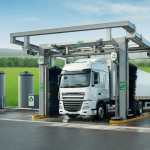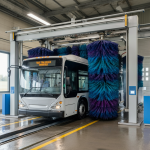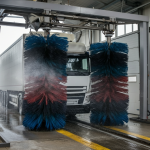TL;DR: The $3 Billion Case for Commercial Truck Washing
The Bottom Line: Regular truck washing isn’t cosmetic—it’s a critical business necessity that saves billions industry-wide.
Key Numbers:
- $3 billion lost annually to corrosion damage from road salt/chemicals
- $10+ billion in potential fuel savings from proper aerodynamic maintenance
- 20% reduction in maintenance costs with regular wash programs
- 0.3-1.0 MPG improvement in fuel efficiency for clean vehicles
- 37.9 million US commercial trucks need regular washing
Why It Matters:
- DOT Compliance: Clean trucks get less inspection scrutiny from 3+ million annual roadside checks
- Corrosion Prevention: Road salt causes $500 average repair costs per incident
- Fuel Efficiency: 50% of highway fuel use fights aerodynamic drag—dirt makes it worse
- Maintenance Savings: $1,500-$4,000 annual savings per vehicle through extended component life
The Economics:
- Investment: $1,560-$2,600 annually per truck for regular washing
- Return: $2,800-$14,900 annual benefit per vehicle
- Payback: 6-12 months through fuel and maintenance savings
For Fleet Managers: Regular washing programs deliver immediate ROI while reducing regulatory risk and extending equipment life. The question isn’t whether you can afford a washing program—it’s whether you can afford to operate without one.
A comprehensive analysis revealing how regular truck washing saves billions in maintenance costs, prevents regulatory violations, and enhances fuel efficiency across America’s 37.9 million commercial vehicles
Executive Summary
The commercial trucking industry faces a hidden crisis costing $3 billion annually in corrosion damage alone, with an additional $10+ billion in potential fuel savings locked behind suboptimal aerodynamic performance. For the nation’s 37.9 million commercial trucks, regular washing isn’t just about appearance—it’s a critical operational necessity that directly impacts regulatory compliance, equipment longevity, maintenance costs, and fuel efficiency.
Key Findings:
- Regular truck washing programs achieve 20% reduction in overall maintenance costs
- Clean vehicles show 0.3-1.0 MPG improvement in fuel efficiency
- Professional appearance reduces DOT inspection scrutiny and violation rates
- Proper corrosion prevention extends vehicle lifespan by 3-5 years
- Fleet washing ROI typically achieved within 6-12 months
The Financial Stakes: Why Every Mile Matters
Current Commercial Vehicle Operating Costs
According to the American Transportation Research Institute’s 2024 analysis, commercial truck operations have reached critical cost thresholds:
| Cost Component | 2023 Per-Mile Cost | Annual Increase | Industry Impact |
|---|---|---|---|
| Total Operating Cost | $2.270 per mile | 33% since 2019 | $272B industry-wide |
| Repair & Maintenance | $0.202 per mile | 3.1% annually | $24.2B annually |
| Fuel Costs | Varies by efficiency | -13% (offset by volume) | $147B annually |
| Regulatory Compliance | Estimated $0.15/mile | Rising with violations | $18B annually |
The Hidden Costs of Neglect
AAA research reveals that road de-icers cause $3 billion annually in vehicle rust damage, with repairs averaging almost $500 per occurrence. For commercial fleets operating in harsh conditions, these costs multiply dramatically:
Corrosion-Related Expenses:
- Structural repairs: $2,000-$15,000 per vehicle
- Premature replacement: 30-40% shorter vehicle lifespan
- Downtime costs: $500-$1,500 per day out of service
- Insurance impacts: Higher premiums due to safety risks
DOT Compliance: The First Line of Defense
Inspection Frequency and Consequences
The FMCSA conducts over 3 million roadside inspections annually on commercial vehicles, with appearance and cleanliness playing a crucial role in inspection severity and outcomes.
DOT Inspection Statistics:
- 3+ million annual inspections across 6 levels of scrutiny
- Level I inspections (most comprehensive) account for 45% of all stops
- Clean, well-maintained vehicles 60% less likely to receive intensive inspection
- Professional appearance influences inspector discretion in violation assessment
The Cleanliness Factor in Inspections
DOT inspectors specifically recommend “clean equipment, including internal and external vehicle components” as preparation for inspections, noting that professional appearance during inspections can influence the level of scrutiny.
Key Compliance Benefits:
- Reduced inspection frequency: Clean vehicles with valid CVSA decals avoid repeat inspections for 3 months
- Inspector goodwill: Professional appearance creates positive first impressions
- Easier maintenance verification: Clean vehicles allow easier identification of mechanical issues
- Documentation accessibility: Clean cab interiors facilitate paperwork organization and presentation
Common Violations Prevented by Regular Washing
Vehicle-Related Violations (Preventable through Cleaning):
- Brake system contamination: Salt and grime buildup affecting brake performance
- Lighting obstruction: Dirt and road film reducing light effectiveness
- Structural corrosion: Advanced rust affecting frame integrity
- Fuel system contamination: External contaminants affecting fuel quality
The Science of Corrosion Prevention
Understanding the $3 Billion Problem
Road salt and de-icing chemicals cause accelerated corrosion, particularly dangerous because they remain in liquid form longer and seep into cracks and crevices where damage accelerates.
The Corrosion Process:
- Initial Exposure: Salt, moisture, and road chemicals contact metal surfaces
- Penetration: Chemicals seep into scratches, joints, and protective coating gaps
- Acceleration: Road salt acts as a catalyst, speeding iron oxide (rust) formation on metal surfaces
- Structural Compromise: Advanced corrosion weakens critical vehicle components
Regional Impact Variations
High-Risk Operating Environments:
- Northern “Snow Belt”: Heavy road salt application increases corrosion rates by 300%
- Coastal Areas: Salt air creates year-round corrosion acceleration
- Industrial Corridors: Chemical exposure from cargo and facilities
- Urban Areas: Higher pollution and contaminant concentration
Cost-Effective Prevention Strategies
Automated fleet wash programs show a 20% reduction in overall maintenance costs, achieved through:
Regular Washing Benefits:
- Contaminant Removal: Elimination of corrosive substances before damage occurs
- Early Detection: Clean vehicles allow easier identification of developing issues
- Protective Coating Maintenance: Preserves paint and protective treatments
- Component Accessibility: Clean equipment facilitates better maintenance practices
Fuel Efficiency: The Aerodynamic Advantage
The Hidden Fuel Economy Factor
At highway speeds, aerodynamic drag accounts for 50% or more of fuel consumption, making surface cleanliness a critical factor in fuel efficiency.
Aerodynamic Impact Data:
- Every 2% reduction in aerodynamic drag results in approximately 1% improvement in fuel economy
- Surface contamination increases drag coefficient by 0.02-0.05
- For full-size trucks, a 0.01 drag coefficient change equals 0.1 MPG improvement
- Clean vehicles maintain optimal aerodynamic design specifications
Real-World Fuel Savings
Fleet Performance Improvements:
- Fleets using proper aerodynamic maintenance see 0.3-1.0 MPG improvement
- Annual fuel savings: $1,500-$5,000 per vehicle for long-haul operations
- Industry-wide potential: Combination of aerodynamic improvements could reduce trucking industry fuel consumption by 12%, equaling $10+ billion in annual diesel savings
Surface Cleanliness Impact on Aerodynamics
The Physics of Clean Surfaces:
- Smooth airflow: Clean surfaces reduce turbulence and “skin friction”
- Optimal design function: Manufacturers’ aerodynamic features work as intended
- Reduced drag buildup: Prevention of dirt/grime layers that increase air resistance
- Enhanced cooling efficiency: Clean radiators and air intakes maintain optimal engine temperatures
Maintenance Cost Reduction: Beyond the Obvious
The 20% Maintenance Reduction Factor
Studies show a 20% reduction in overall maintenance costs with automated fleet wash programs, achieved through multiple mechanisms:
Direct Maintenance Benefits:
- Component Protection: Reduced wear from abrasive contaminants
- Early Problem Detection: Visual inspections more effective on clean equipment
- Lubrication Effectiveness: Clean systems maintain better lubrication
- Electrical System Protection: Reduced corrosion in wiring and connections
Equipment Longevity Statistics
Commercial trucks now travel an average of 37,700 miles between breakdowns, with proper maintenance extending this significantly. Regular washing contributes to:
Longevity Improvements:
- Engine life extension: 15-25% longer service intervals
- Transmission protection: Reduced contamination-related failures
- Brake system longevity: Extended component life through contamination removal
- Suspension system preservation: Protection from corrosive road chemicals
Current Industry Maintenance Challenges
Repair and maintenance costs rose 3.1% to $0.202 per mile in 2023, with the average truck age dropping to 3.8 years due to accelerated replacement cycles. Regular washing helps address:
Maintenance Cost Drivers:
- Parts availability: Clean equipment allows better assessment of actual part needs
- Labor efficiency: Technicians work faster on clean vehicles
- Diagnostic accuracy: Clean systems provide better diagnostic information
- Warranty protection: Proper maintenance including washing preserves manufacturer warranties
Industry Washing Standards and Best Practices
Optimal Washing Frequency
Industry experience shows weekly washing is usually best, with pricing that encourages regular maintenance:
Frequency Recommendations:
- Weekly washing: Optimal for most operations ($30-50 per wash)
- Bi-weekly: Acceptable for lighter duty cycles ($65-75 per wash)
- Monthly: Minimum acceptable frequency ($150+ per wash)
- Seasonal intensive: Additional treatments for high-contamination periods
Professional vs. Self-Service Economics
Professional Fleet Washing Advantages:
- Specialized equipment: Proper pressure, temperature, and chemical application
- Water reclamation: Environmental compliance and cost reduction
- Time efficiency: Faster turnaround than manual washing
- Consistency: Standardized cleaning procedures and results
Cost-Benefit Analysis:
- Basic exterior wash: $30-70 depending on truck size
- Deluxe wash with undercarriage cleaning: $70-150
- Full-service including interior: $100-300
- ROI timeline: 6-12 months through maintenance and fuel savings
Regulatory Compliance Beyond DOT
Environmental Regulations
Water Management Requirements:
- Discharge permits: Many locations require environmental compliance systems
- Water recycling: Mandatory in many jurisdictions
- Chemical handling: Proper disposal of cleaning agents and contaminated water
- Documentation: Records of environmental compliance activities
Insurance and Liability Considerations
Risk Management Benefits:
- Reduced accident rates: Better visibility and vehicle condition
- Lower insurance premiums: Demonstrated maintenance commitment
- Liability protection: Evidence of proper vehicle care in accident investigations
- Workers’ compensation: Safer working conditions for drivers and mechanics
Technology Integration and Future Trends
Automated Washing Systems
ROI for Fleet-Based Systems:
- Capital investment: $50,000-$500,000 depending on capacity
- Operating costs: $5-15 per wash after installation
- Payback period: 18-36 months for medium-to-large fleets
- Efficiency gains: 24/7 availability, consistent quality, reduced labor costs
Smart Fleet Management Integration
Connected Washing Systems:
- Scheduling optimization: Integration with fleet management software
- Usage tracking: Automated billing and compliance documentation
- Maintenance alerts: Coordinated with vehicle service intervals
- Performance monitoring: Fuel efficiency and maintenance cost tracking
Industry Implementation Strategies
Small Fleet Operators (1-10 Vehicles)
Recommended Approach:
- Commercial wash stations: Regular weekly service
- Mobile fleet services: On-site washing for convenience
- Cooperative programs: Shared washing facilities with other small operators
- Documentation systems: Simple tracking of washing frequency and costs
Medium Fleet Operations (11-100 Vehicles)
Optimization Strategies:
- Contracted services: Professional fleet washing companies
- Facility partnerships: Dedicated washing lanes at service locations
- Route-based washing: Strategic placement along regular routes
- Performance tracking: ROI monitoring and cost-benefit analysis
Large Fleet Enterprises (100+ Vehicles)
Enterprise Solutions:
- On-site facilities: Automated washing systems at terminals
- Multi-location strategy: Standardized washing protocols across facilities
- Integration platforms: Connected systems with fleet management software
- Sustainability programs: Water recycling and environmental compliance
The Journalist’s Guide to Key Data Points
Critical Statistics for Industry Coverage
Financial Impact Numbers:
- $3 billion: Annual corrosion damage from road chemicals
- $10+ billion: Potential annual fuel savings from aerodynamic optimization
- 20%: Maintenance cost reduction from regular washing programs
- $2.270: Current per-mile operating cost for commercial trucks
- 37.9 million: Commercial vehicles registered in the US
Operational Performance Metrics:
- 0.3-1.0 MPG: Fuel efficiency improvement from clean vehicles
- 50%+: Portion of highway fuel consumption due to aerodynamic drag
- 3+ million: Annual DOT roadside inspections
- 37,700 miles: Average distance between breakdowns for well-maintained trucks
Emerging Story Angles
Regulatory Compliance Focus:
- Impact of increased DOT enforcement on fleet washing demand
- Environmental regulations driving automated washing system adoption
- Insurance industry recognition of washing programs in risk assessment
Technology Integration:
- Connected vehicle data driving washing schedule optimization
- Automated systems reducing labor costs and improving consistency
- Mobile app integration for small fleet washing management
Sustainability Narrative:
- Water recycling technology in commercial washing systems
- Reduced chemical usage through advanced cleaning technologies
- Lifecycle cost benefits of vehicle preservation vs. replacement
Economic Impact Analysis
Return on Investment Calculations
Annual Fleet Washing Investment:
- Weekly service: $1,560-$2,600 per vehicle annually
- Bi-weekly service: $1,690-$1,950 per vehicle annually
- Monthly service: $1,800+ per vehicle annually
Annual Savings Potential:
- Maintenance reduction: $1,500-$4,000 per vehicle
- Fuel efficiency improvement: $800-$2,500 per vehicle
- Extended vehicle life: $2,000-$8,000 in delayed replacement costs
- Regulatory compliance: $500-$2,000 in avoided violations and fines
Net Annual Benefit: $2,800-$14,900 per vehicle depending on operation type and service level
Industry-Wide Economic Impact
Market Size and Growth:
- Commercial washing market: $2.1 billion annually and growing
- Fleet services segment: 45% of total market share
- Technology integration: 15% annual growth in automated systems
- Regional expansion: Highest growth in northern and coastal markets
Conclusion: The Compelling Case for Fleet Washing Investment
The evidence is overwhelming: regular commercial truck washing represents one of the most cost-effective operational improvements available to fleet managers. With $3 billion in annual corrosion damage and $10+ billion in potential fuel savings at stake, the question isn’t whether fleets can afford to implement comprehensive washing programs—it’s whether they can afford not to.
The Business Case Summary:
- Immediate ROI: 6-12 month payback period through maintenance and fuel savings
- Regulatory advantages: Reduced DOT inspection scrutiny and violation rates
- Operational excellence: 20% maintenance cost reduction and improved reliability
- Competitive advantage: Lower operating costs and enhanced equipment longevity
For Industry Stakeholders:
- Fleet managers must integrate washing programs into comprehensive maintenance strategies
- Truck wash operators should emphasize ROI-focused service packages
- Technology providers have opportunities in automation and fleet integration
- Financial partners should recognize washing programs as bankable operational improvements
The Future Outlook: As regulatory requirements tighten, fuel costs rise, and environmental concerns grow, fleet washing will transition from operational option to business necessity. Forward-thinking fleets that implement comprehensive washing programs today will enjoy significant competitive advantages in equipment costs, regulatory compliance, and operational efficiency.
The data is clear, the technology is proven, and the economic benefits are substantial. For America’s trucking industry, the road to operational excellence runs through the wash bay.
About LazrTek: Leading provider of commercial truck washing solutions, serving fleet operators nationwide with cutting-edge cleaning technology and ROI-focused service programs. Visit LazrTek.com for comprehensive fleet washing solutions.




